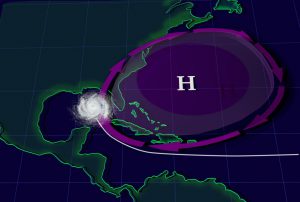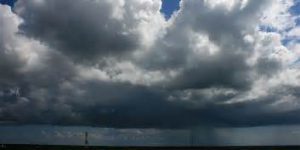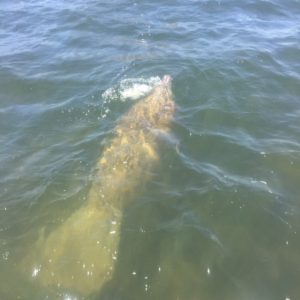2017 began as most years do, the Bermuda high slid east across the Atlantic Ocean and the cold fronts began to reach the Gulf Coast. However, this past winter was milder than normal. Either the high did not slide as far east as it typically does, or the fronts did not pack the punch they normally do – but we did not have as many deep freezes in 2017. That’s how it began.

Image: Goddard Space Center NASA
As spring approached the Bermuda High made its’ annual move westward, bringing us the clockwise winds from the southeast and moisture from the Gulf. It was time for rain… and rain it did. It rained and rained and rained. It rained so much that the salinities in the local bayous in Pensacola, which typically run between 10-15 parts per thousands, were below 1 ppt – freshwater. These heavy rains triggered high bacteria counts in the water column, which triggered health advisories – increasing 139% this year.
Late spring and summer is the season of afternoon thunderstorms – and Sea Grants’ estuary monitoring programs in Pensacola Bay. This year we observed many things:
- Numerous bald eagles, more than we had seen before
- Communities calling about snake encounters – this is not unusual when it rains, but this year there were more venomous snakes than we typically see.
- We began to get calls concerning Cuban Anoles (an invasive lizard) all along the coast from Perdido Key to Gulf Breeze. As more people searched, more anoles were found. I saw the first two at my house this year.
- We were searching for horseshoe crabs, and found them! In several locations in the lower bay, but never found where they were nesting – we will continue to search in 2018.
- Our terrapin surveys extended to Walton County. We found two new terrapin nesting beaches in Escambia and the sea turtle nests reached record numbers across the state.
- Our scallop surveys in Santa Rosa Sound and Big Lagoon were a complete bust due to the rain. Either it was raining, or the visibility was so poor you could not see. An algal bloom occurred in St. Joe Bay that closed scalloping for most of the season.
- We began a seagrass monitoring project with the University of West Florida. This was a tough year to begin due to the poor visibility, but we will continue in 2018.
- Manatee sightings were reported in Big Lagoon and Santa Rosa Sound. Again, this is not that unusual but the number of sightings, the number of manatees together, and the length of time they remained in the bay were.
- And then the mangroves – nine red mangroves were reported in Big Lagoon. Sea Grant will be working with Dauphin Island Sea Lab and resource managers from NERRS in Florida, Alabama and Mississippi to search for more mangroves in the northern Gulf in 2018.
- And the rain continued…

Photo: Stuart Heath, NOAA
As summer moves into fall the Bermuda High typically begins to slide eastward, taking with it the “protection” from summer hurricanes – and the hurricanes came. First, it was Harvey, then Irma, then Maria, and then Nate. All had their impacts on the area.
- First were the flamingos in Pensacola, three of them, photographed in different locations around the bay – then they were gone.
- Numerous flocks of white pelicans. They typically fly through the area but there appeared to be more than we normally see and reports of them landing across the area increased.
- We received calls about “invasive” plants growing in the bayou – which turned out to be freshwater plants that had taken advantage of the freshwater conditions in our bayous from the heavy rains.
- The snake encounters did not decrease
- The mangroves continued to grow
- The manatee sightings continued into the fall
- And the rain continued
How did this season fare with local seafood (Escambia County only)?
- There was a 17% decrease in the number of species harvested – from 59 to 49
- And an 11% decrease in the price/lb. fishers received for their seafood – from $2.20/lb. to $1.95/lb.
- But there was a 33% increase in the pounds of seafood reported – from 839,673 to 1,121,225 lbs.
- A 38% increase in the number of trips reported – from 2,658 to 3,664 trips
- And a 25% increase in the estimated value of the local seafood harvest – from $1,589,518 to $1,991,286 – vermillion snapper, red snapper, and striped mullet remain our top three target species.

Photo: Marsha Stanton
We are now moving into winter. The Bermuda High has moved across the Atlantic. This typically begins a dry season – and it has been dry for several weeks. It also allows cold fronts to reach the coast – and they did. On December 9, it snowed in Pensacola. Who knows what 2018 will bring but we will continue to be in the field monitoring and observing. There are opportunities for locals to volunteer for some of our monitoring projects, and there are other agencies and NGOs in the area seeking volunteers for monitoring and restoration projects. Join us if you like, and have a very happy holiday season.
 0
0
